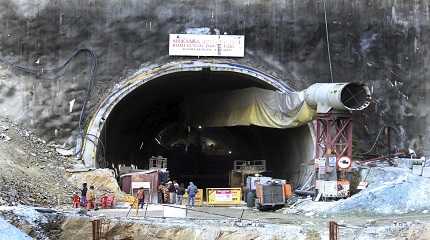
UTTARKASHI, India (AP) — Rescuers in India on Tuesday reached 41 construction workers who were trapped in a collapsed mountain tunnel for over two weeks in the country’s north and started pulling them out, a local news agency reported.
One worker has been rescued so far, the report by the Press Trust of India said. The laborers are being pulled out through a passageway made of welded pipes which rescuers previously pushed through dirt and rocks.
The rescue mission has grabbed the country’s attention for the past 17 days. The workers got trapped on Nov. 12, when a landslide caused a portion of the 4.5-kilometer (2.8-mile) tunnel they were building in Uttarakhand state to collapse about 200 meters (650 feet) from the entrance.
They survived on food and oxygen supplied through narrow steel pipes. After being pulled out, they will be taken to a makeshift health center inside the 13-meter (42.6 feet) wide tunnel, officials said.
“Soon all the laborer brothers will be taken out,” Pushkar Singh Dhami, top official in Uttarakhand, had posted on the social media platform X, formerly known as Twitter, earlier on Tuesday, when there were only a few feet remaining to be ug out.
Kirti Panwar, a state government spokesperson, said about a dozen men had worked overnight to manually dig through rocks and debris, taking turns to drill using hand-held drilling tools and clearing out the muck in what he said was the final stretch of the rescue operation.
Rescuers resorted to manual digging after the drilling machine broke down irreparably on Friday while drilling horizontally from the front because of the mountainous terrain of Uttarakhand. The machine bored through about 47 meters (nearly 154 feet) out of approximately the 57-60 meters (nearly 187-196 feet) needed, before rescuers started to work by hand to create a passageway to evacuate the trapped workers.
Hasnain said rescuers had managed to drill through more than 58 meters (190 feet) so far.
As dusk fell Tuesday, families of those trapped underground gathered near the site of the accident, anxiously waiting to see their loved ones emerge from the tunnel.
Among them was Jaimal Singh who said he was hopeful he would soon see his brother Gabbar Singh, who is trapped inside. “Even nature looks cheerful today ... the weather is good. Let’s hope this ends soon,” he told the Press Trust of India news agency.
Rescue teams have inserted pipes into dug-out areas and welded them together so the workers could be brought out on wheeled stretchers.
The laborers have been trapped since Nov. 12 when a landslide caused a portion of the 4.5-kilometer (2.8-mile) tunnel they were building to collapse about 200 meters (650 feet) from the entrance.
Rescuers on Sunday also began to create a vertical channel with a newly replaced drilling machine as a contingency plan.
What began as a rescue mission expected to take a few days has turned into weeks, and officials have been hesitant to give a timeline for when it might be completed.
“I just feel good. The drilling on top of the mountain is coming along perfectly, in the tunnel, it’s coming along very well. I have never said ‘I feel good’ before,” Arnold Dix, an international tunneling expert who is helping with the rescue, told reporters at the site on Tuesday.
Most of the trapped workers are migrant laborers from across the country. Many of their families have traveled to the location, where they have camped out for days to get updates on the rescue effort and in hopes of seeing their relatives soon.
Authorities have supplied the trapped workers with hot meals through a 6-inch (15-centimeter) pipe after days of surviving only on dry food sent through a narrower pipe. They are getting oxygen through a separate pipe, and more than a dozen doctors, including psychiatrists, have been at the site monitoring their health.
The tunnel the workers were building was designed as part of the Chardham all-weather road, which will connect various Hindu pilgrimage sites. Some experts say the project, a flagship initiative of the federal government, will exacerbate fragile conditions in the upper Himalayas, where several towns are built atop landslide debris.
Large numbers of pilgrims and tourists visit Uttarakhand’s many Hindu temples, with the number increasing over the years because of the continued construction of buildings and roadways.




